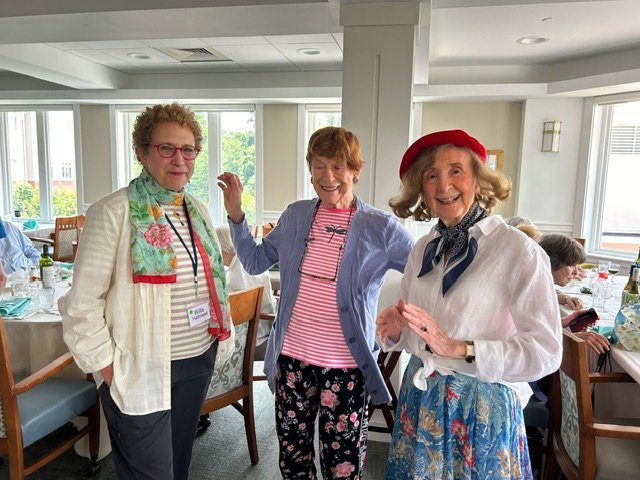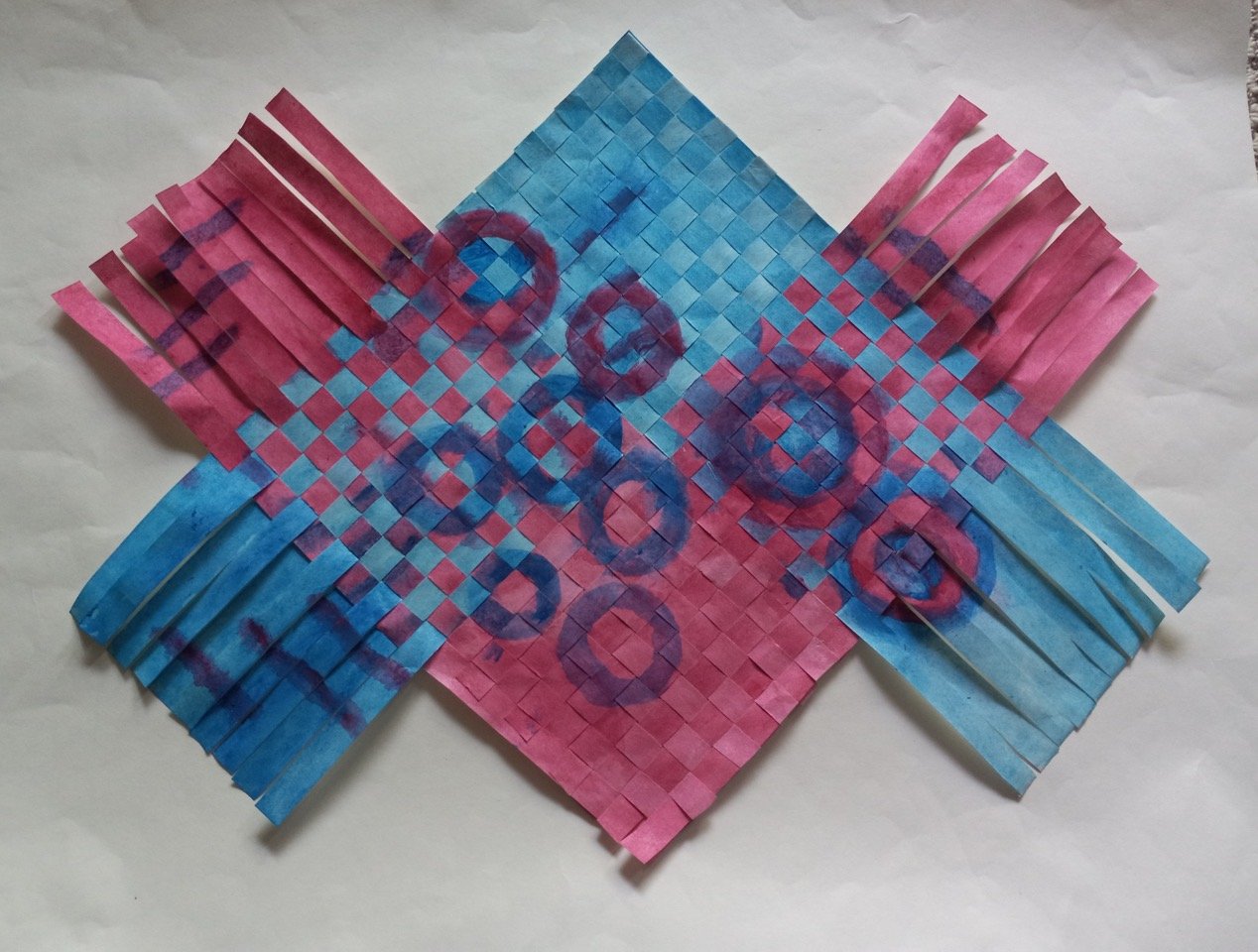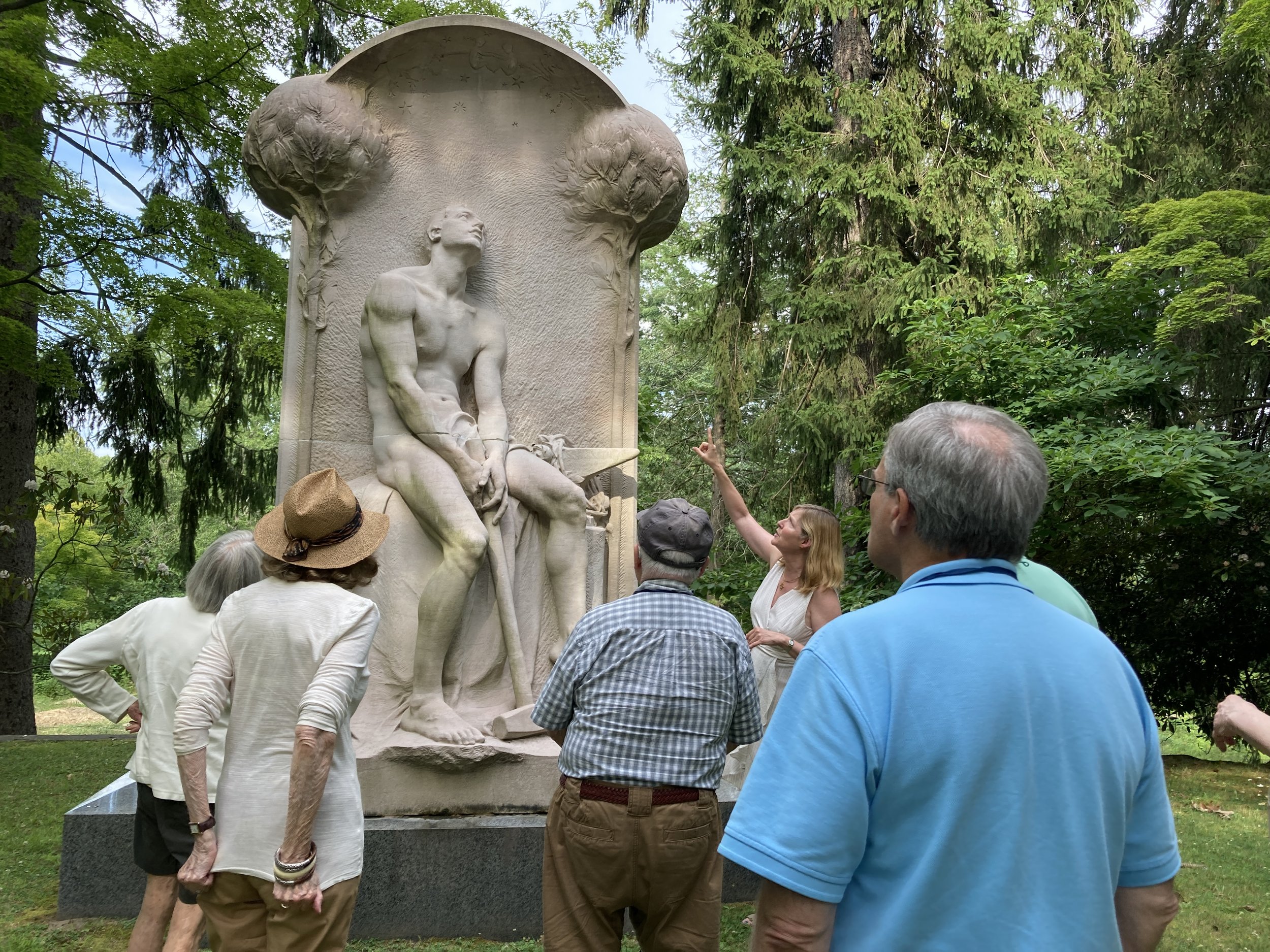Poetry by Sheila Benedis
Let Thoughts Breathe
messages come through the air
hear the way the wind rustles the leaves
creates shifts in scent
observe the way the light comes through the trees
shimmers in noonday sun
suggesting rhythmical movement
I feel it within myself
messages come through the air
take time to hear the whispers
of what nature is trying to tell me
listen
let thoughts breathe
Art by Hart
Ms. Minch, the new company troubleshooter, had her work cut out for her
Everett’s new water ballet was an instant classic
Tootsie had had just about enough of Franklin’s bellyaching
Mrs. Jordan’s flamenco coach suggested castenets instead of gelato
Unsure where she’d left her phone, Lucia had to retrace her steps
Art and photos by Jane Hart
In and Around Kendal
The Power of a Glorious Sunset
Photo by Harry Bloomfeld
Bastille Day a la Kendal
Les Invites
Les Filles Can Can
A-a-ah, La Romance!
La Femme Française Authentique (Regardez Vous: Le Béret!)
Les Amis
La Danse Fantastique
Un Autre Béret! Ooolala!
Le Can Can Fini
Photos by Carolyn Reiss
A Mackerel Sky as Evening Turns to Night
Photos by Jane Hart
While Strolling Through the Park One Day . . .
Photos by Carolyn Reiss
The Storm
Photo by Carolyn Reiss
Out and About
Nature’s Eye Candy
Photo by Edward Kasinec
Semicolon-oscopy by a Real, Live Doctor
From the desk (and pen) of Dr. Norman Sissman (a real-life doctor!):
I suspect that many Kendal residents have spent agitated nocturnal hours awake, trying to decide when to use a semicolon or a colon when composing their contributions to the world’s literature. So — here comes the sleep doctor with his recommendation to relieve their grammatic insomnia. Be assured that my remedy has not been superficially or casually arrived at; I have consulted authorities from the 1959 revered classic, Strunk and White’s The Elements of Style, to the anonymous experts at Wikipedia (to whom we often turn for facts nowadays).
A semicolon joins two related clauses when neither is long enough or complete enough to stand as independent sentences. A colon introduces examples of a subject mentioned in the first part of a sentence; it can be replaced by the words, “which is/are” or “as follows.” Here is an example: “During his presidency, Donald Trump established policies that had detrimental effects on the prosperity and security of our country: cutting taxes on corporations and rich individuals, thus sending our national debt skyrocketing; closing a federal pandemic preparedness unit, thus allowing COVID to spread unnecessarily; withdrawing the U.S. from a treaty with Iran that had put on hold that country’s efforts to develop nuclear weapons; and encouraging a violent mob to storm a congressional building to try to reverse the legitimate results of a presidential election.”
So – read this prescription once daily at bedtime, and sleep well!
* * * * * * * * * *
Thank you, Dr. Sissman. We found Dr. Sissman’s explanation so compelling, that we wanted to know even more about the too-oft-denigrated semicolon. Where else would we go but to the Puncuationist of All Time (yes, that is a title we just made up, but it fits): The New Yorker’s Comma Queen, Mary Norris? She was, of course, profound. To learn even more about the semicolon, click below.
And why not go one step further and check out the Comma Queen’s brief video on, yes, the mighty semicolon.
If the Shoe Fits . . .
High Heels: Originally the Choice for Men
Long before the days of stilettos and pumps, kitten heels and wedges, high-heeled shoes were worn by men. As far back as the 10th century, Persian soldiers and emissaries wore heels when riding, battling, or traveling to faraway lands. These heels weren’t for show, however; they were for function. When a soldier wore heeled boots on a horse, he was able to better steady himself and generate more balance both for riding and fighting. Persian soldiers were also able to stand upright in their stirrups, positioning their feet so the space between the heel and the sole was snug in the stirrup, which gave them an advantage in battle.
Once heels made their way to Europe in the 16th century, their purpose was much more akin to how we think of these shoes today. Men in the French, Spanish, German, and Russian courts wore heels to project height and physical stature in order to intimidate rivals and foreign diplomats in court. Over the course of the next 200 years, men’s heels got shorter and stockier — making the shoes better for balance and walking, and less of an ornate fashion statement. By the 18th century, high heels faded out of fashion for men, who started to favor less flamboyant clothing and accessories.
When women started to wear high heels, the goal was to hide as much of the foot as possible beneath a long skirt. The peeking toe suggested a small foot, showing daintiness. Though sneakers are far more popular than heels today, the concept of the “platform sneaker” suggests that the ethos of the high heel is not yet a thing of the past.
Source: historyfacts.com
Contributed by Jane Hart
In Case of Rockland Park Emergency . . .
During park hours call the park office for goats and other park issues such as damage to the bird condo:
914-631-1470 — when prompted press 0
After hours and for immediate danger call the Mount Pleasant Police:
914-769-1941.
Note: do NOT call Sleepy Hollow Police.
This message is approved by Ranger Su.
Contributed by Carolyn Reiss
Made In NYC: Brands, Trends, and Inventions That Began in the Big Apple
Barnes & Noble
Barnes & Noble is the biggest bookstore chain in the US, with billions in annual revenue. It started out in the East Village in 1886, as a single shop inside Cooper Union. Arthur Hinds and Company was the original name, until an early-hire clerk named Gilbert Clifford Noble joined. The Hinds & Noble name changed again when William Barnes came on. The company is still headquartered in Manhattan today.
The Co-Op Apartment
Given the complexities of finding a place to live in New York City it makes sense the city pioneered the co-op apartment. Designed to lower the cost of living, with a shared staff and ice and coal bought at bulk rates, the concept was a success and soon migrated around the globe. The world’s first example was at 152 West 57th Street, a building called The Rembrandt.
Macy’s
Rowland Hussey Macy founded Macy’s on the corner of 14th Street and Sixth Avenue in 1851. The brand peaked at 850 locations and along the way added some retail innovations that are everywhere today, including the concept of a department store, cash transactions, set prices instead of haggling, tailoring services, in-shop Santa visits, and holiday windows.
Source: “Made In NYC,” by Ethan Wolff, March 2024, City Guide New York
Contributed by Bobbie Roggemann
Stay tuned for more . . .
For Your Funny
Contributed by Barbara Bruno
Contributed by Barbara Bruno
Art by Hart
Minerva loved communing with nature at the lake
The little broccolini girl was growing up bitter
The new opera based on Jaws was dead in the water
Miss Kirkbright’s mani-pedi was costing an arm and a leg
Mrs. Peck spent a lot on all her outfits
Val’s millinery was rarely dull
Art and photos by Jane Hart
Meditation 5, by Sheila Benedis
In and Around Kendal
A Healing Garden for Body and Soul
Known as the Healing Garden, Kendal’s very own oasis is open to all. It’s a lovely place to sit and think, read, or just talk with friends, whether they be staying (permanently or temporarily) in Clearwater or not. Here’s a glimpse into its beauty:
Photos by Maggie Limburg
Artists at Work
Hard at work for the benefit of Kendal’s Art Committee — and their own enjoyment — is a band of Kendal artists who design and create the wonderful cards that go on sale twice a year. Their commitment — and their creativity — is a joy to behold.
Photo by Haruko Ogasawara
Out and About
Sleepy Hollow Cemetery Tour
On July 9, a van-load of Kendalites took a trip to Sleepy Hollow Cemetery — and returned to tell the tale! The final resting place of the famous, non-famous, and infamous alike, they visited select graveside monuments and heard stories beyond the grave told by Christina Urban-LaSalle, Director of Visitor Services.
Henry Villard told his own story on the back of his monument, but Christina told it better.
Steel magnate Andrew Carnegie chose a modest monument with carved Celtic knots. He acquired considerable wealth and was noted for his philanthropy.
While some graveside monuments were simple or wordy, some let the monument itself tell a story.
Photos by Marianne Bloomfeld
Away for the Summer
Cynthia Ferguson and family are livin’ the good life up in Lake George, experiencing their own version of lovely sunsets.
Occasional visitors include a friendly neighborhood beaver.
Photos by Cynthia Ferguson
Electronic Devices Driving You Nuts? Help Is Available!
July 18, starting at 1:30 pm, bring those problematic laptops, cell phones, etc. to the Residents Association Office and get the help you’ve been longer for.
The Computer Committee provides diagnostic and curative assistance that leaves the rest of us in awe.
Even if your hardware (i.e. physical equipment) isn’t a problem, if you have questions about “how to,” come on in!
Don’t be shy! Help is not only on the way . . . but there!
I Never Knew That . . .
Why Are They Called “Restaurants”
The word “restaurant” literally means “food that restores” and once referred to broths.
French cuisine is often considered the epitome of fine dining, and that could be because French cooks are said to have launched the modern restaurant — and even invented the word “restaurant” itself. Many etymologists and historians attribute the origins of both to A. Boulanger, a Parisian soup vendor who set up shop in 1765. Boulanger peddled bouillons restaurants — so-called restorative meat and vegetable broths, from the French restaurer, meaning “to restore or refresh” — an act that wasn’t entirely revolutionary, since other cooks were selling healing soups from “health houses” around the same time. But Boulanger’s approach was different because he also offered a menu of other meals at a time when most taverns and vendors served just one option, dictated by the chef.
Boulanger’s concept of seating guests and allowing them to choose their desired meal exploded in popularity after the French Revolution at the end of the 18th century, as kitchen workers who formerly served aristocratic households set up their own dining rooms or joined new eateries. By 1804, French diners could choose from more than 500 restaurants across the country.
But, while the etymology of “restaurant” is settled, is that the true story of the origin of public feeding venues? Some historians disagree with this long-told tale of the restaurant’s origin, suggesting there isn’t much evidence by way of historical documentation to prove Boulanger was a real person. And others believe attributing the public dining room to French ingenuity isn’t wholly accurate, since humans have been offering up their cooking talent to the hungry masses for millennia. Take, for example, how Chinese chefs in major cities such as Kaifeng and Hangzhou customized menus to appeal to traveling businessmen looking for familiar meals nearly 700 years before France’s iteration of the restaurant. Or the excavated ruins at Pompeii dating to 79 CE that include ornately decorated food stalls called thermopolia, where hungry Romans could choose from a variety of ready-to-eat dishes. Though the names have differed, smart humans have been selling snacks to each other for a long, long time.
Source: Interestingfacts.com
Contributed by Jane Hart
For Your Funny Bone
Poetry and Art by Sheila Benedis
power of a tree
just look just listen
my footsteps move slowly
like dancing shadows
my faint melodies go unnoticed
but they tell a story
echoes of dreams
like the trail
a snail leaves behind
if only I could become a tree
peace and hope would be
possible in the world
a tree could turn on a light
Seasons in Leaves
Art by Hart
Hambright's apartment was short on square footage, but the high ceilings provided lots of wall space
Fendleman’s stories were complicated
Celia had storm debris to deal with
The Tour de France officials had to say no
At Camp Woofy, all the kids could be who they were
Art and photos by Jane Hart
In and Around
By the Rockets’ Red Glare
Whether on the near or the far banks of the Hudson, the Fourth of July is a time for the awe and beauty of fireworks.
The Nyack brand, seen reflected in the Hudson (and photographed by Art Brady):
Or Fireworks seen reflected in Clermont’s
Photo by Carolyn Reiss
Bocce, Kendal-Style
When it’s not too cold and not too hot — and, definitely not too wet — Kendal’s Bocce athletes come together on the Bocce Court (aka the lawn between Alida and Fulton) on Wednesdays at 1:30. On July 3, Pace students Alejandra and Jessica, interning with Physical Therapy, joined them.
Photo by Pete Roggemann
Yes, Goats Have Personalities, Too
“You lookin’ at me?!”
“Oh, my, are you looking at me?”
Photos by Mimi Abramovitz
Senior Artists: Come Meet Senior Artists
The Senior Artists of Tarrytown’s Neighborhood House invite the Senior Artists of Kendal (and those who enjoy their work) to the opening reception of their Senior Art Workshop.
Date: Wednesday, July 10
Time: 1 pm
Place: Warner Library
Come Celebrate Senior Art!















































































